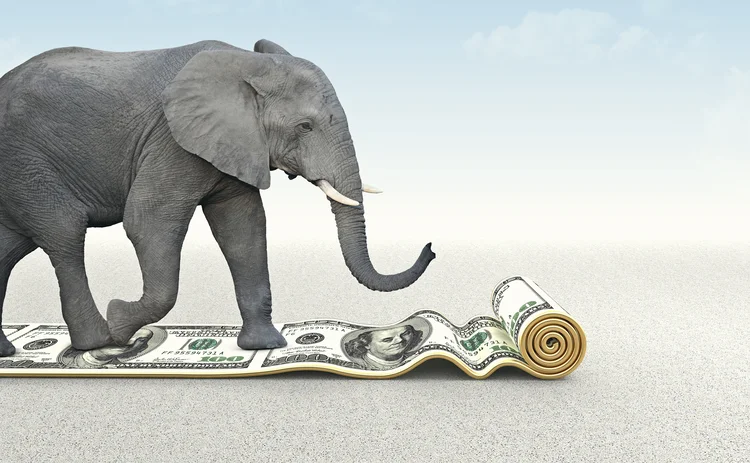
Beware the macro elephant that could stomp on stocks
Macro risks have the potential to shake equities more than investors might be anticipating

After the sharpest tightening of monetary policy in history, central banks are now in rate cutting mode. In such a world, equity investors might imagine macro forces would be buffeting portfolios. That’s largely not happened.
“Nvidia’s earnings have mattered more,” says Abhinandan Deb, head of cross-asset quant strategy at Bank of America. Putting aside the short-lived tumult around the yen carry trade-unwind in August and the accompanying Vix shock, and risk aversion around the US election, implied volatility in US equities has remained in line with long-term averages. It’s as if stock markets have learned to defy gravity, he says.
Partly, this is because markets are gripped by the artificial intelligence story. Today, tech stocks dominate the S&P 500. The stocks of Nvidia et al are naturally less sensitive to broader economic conditions. Buyers are betting on demand for GPUs in an AI revolution, rather than the humdrum of the here and now. “The S&P has become a glorified Nasdaq,” Deb says. “The way tech goes, so the S&P goes. And tech has been impervious to macro.”
But Deb reckons a kind of Pavlovian conditioning of investors is also at play. The “monster” rally in 2020 after the outbreak of the Covid pandemic left investors with a reflex to buy market dips, he says – and to fear selling into them. The Calmar ratio of the S&P 500 in 2020, a measure of cumulative returns versus the market drawdown, was among the highest on record. In the years that have followed, “buying the dip has been one of the strongest sources of alpha”.
Similar levitational effects are visible in European markets, too, despite tech dominance in European indexes being much lower. The Dax index has reached record highs despite a German economic slowdown, political instability and persistent strains in the country’s auto industry.
The question, then, is: can these effects last? Deb and his colleagues at Bank of America have said investors should at least consider prudent hedges in case it doesn’t. Others believe there are signs that macro could take a prominent role sooner than investors might expect.
Waking signs
In early October, market sentiment – proxied by the Cboe’s Vix index – accounted for almost two-fifths of the volatility in a portfolio of stocks favoured by hedge funds, according to analytics from Quant Insight. That makes sentiment the biggest single driver of risk. Not far behind, though, were high yield credit spreads, says the firm’s founder, Mahmood Noorani.
QI’s models estimate the influence of various macro factors on stock volatility and returns, applied in this case to the Goldman Sachs VIP index of hedge funds’ favoured positions.
The contribution of sentiment to risk in the GVIP has been fading from a high in August, it seems. At that time, sentiment accounted for roughly half the annualised volatility of the portfolio. Today, that’s fallen to about a third. Meanwhile, the influence of macro factors that QI categorises under ‘financial conditions’ — broadly, monetary conditions, high yield credit spreads and dollar strength or weakness — has been creeping higher and now is almost catching up.
Whether or not macro forces resurge in the near term, Noorani says their growing importance is part of a longer-term story. The stable level of macro risk in equity portfolios is likely to be higher now than in the past, he argues.
Recent history offers examples of this happening. Macro factors accounted for annualised volatility of nearly 30% in GVIP at the start of the Covid pandemic, roughly two-fifths of the total risk in the portfolio. Volatility from the factors jumped again to contribute more than half the annualised risk in 2022 and 2023, as central banks hiked rates.
Sentiment and stock-specific drivers might appear to dominate today, but Noorani reckons macro will be a source of greater risk in future due to central bank policy uncertainty, more volatile inflation, geopolitical risk, deglobalisation and demographic changes.
His point is that equity portfolio managers who mostly ignored macro forces when interest rates were stuck at near zero can no longer do so. Macro risk tends to “rear its ugly head occasionally”, he says. In the first half of 2022, certain equity market neutral funds suffered because of an implicit bet on rates staying low, he adds.
A generation of equity portfolio managers, meanwhile, may still be getting used to how macro can buffet portfolios. “You do all this hard work to find alpha – this delicate flower that you’ve nurtured,” Noorani says. “What you want to avoid is having the macro elephant stomp on it.”
Only users who have a paid subscription or are part of a corporate subscription are able to print or copy content.
To access these options, along with all other subscription benefits, please contact info@risk.net or view our subscription options here: http://subscriptions.risk.net/subscribe
You are currently unable to print this content. Please contact info@risk.net to find out more.
You are currently unable to copy this content. Please contact info@risk.net to find out more.
Copyright Infopro Digital Limited. All rights reserved.
As outlined in our terms and conditions, https://www.infopro-digital.com/terms-and-conditions/subscriptions/ (point 2.4), printing is limited to a single copy.
If you would like to purchase additional rights please email info@risk.net
Copyright Infopro Digital Limited. All rights reserved.
You may share this content using our article tools. As outlined in our terms and conditions, https://www.infopro-digital.com/terms-and-conditions/subscriptions/ (clause 2.4), an Authorised User may only make one copy of the materials for their own personal use. You must also comply with the restrictions in clause 2.5.
If you would like to purchase additional rights please email info@risk.net
More on Our take
Degree of influence 2024: volatility and credit risk keep quants alert
Quantum-based models and machine learning also contributed to Cutting Edge’s output
Podcast: Alexandre Antonov turns down the noise in Markowitz
Adia quant explains how to apply hierarchical risk parity to a minimum-variance portfolio
Why did UK keep the pension fund clearing exemption?
Liquidity concerns, desire for higher returns and clearing capacity all possible reasons for going its own way
UBS’s Iabichino holds a mirror to bank funding risks
Framing funding management as an optimal control problem affords an alternative to proxy hedging
Trump 2.0 bank supervision: simpler but no soft touch?
Republican FDIC vice-chair Travis Hill wants more focus on financial risk instead of process
Lots to fear, including fear itself
Binary scenarios for key investment risks in this year’s Top 10 are worrying buy-siders
Podcast: Alexei Kondratyev on quantum computing
Imperial College London professor updates expectations for future tech
Quants mine gold for new market-making model
Novel approach to modelling cointegrated assets could be applied to FX and potentially even corporate bond pricing








